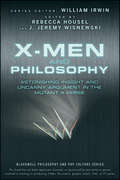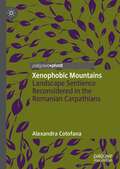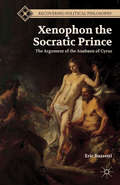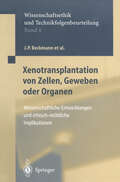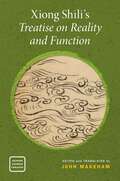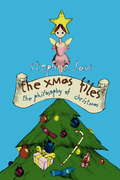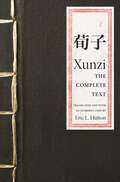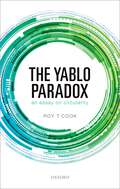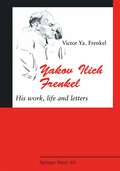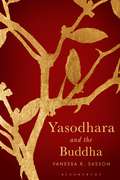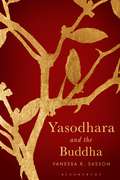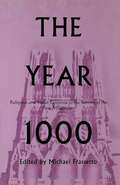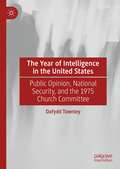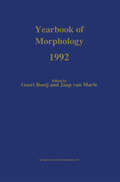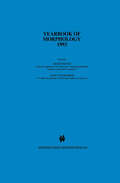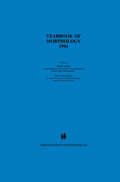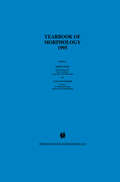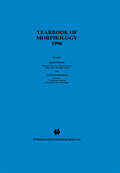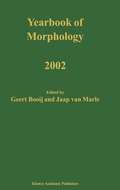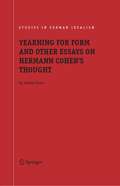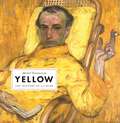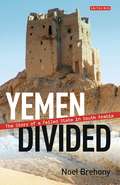- Table View
- List View
X-Men and Philosophy: Astonishing Insight and Uncanny Argument in the Mutant X-Verse (The Blackwell Philosophy and Pop Culture Series #11)
by William Irwin Rebecca Housel Better Homes and Gardens Books Staff J. Jeremy WisnewskiX-Men is one of the most popular comic book franchises ever, with successful spin-offs that include several feature films, cartoon series, bestselling video games, and merchandise. This is the first look at the deeper issues of the X-Men universe and the choices facing its powerful "mutants," such as identity, human ethics versus mutant morality, and self-sacrifice. J. Jeremy Wisnewski (Oneonta, NY) is Assistant Professor of Philosophy at Hartwick College and the editor of Family Guy and Philosophy (978-1-4051-6316-3) and The Office and Philosophy (978-1-4051-7555-5). Rebecca Housel (Rochester, NY) is a professor at Rochester Institute of Technology, where she teaches about writing and pop culture. For William Irwin's biography, please see below.
Xenophobic Mountains: Landscape Sentience Reconsidered in the Romanian Carpathians
by Alexandra CotofanaThis book, based on ethnographic research in Romania, traces the ontological red lines that form a world in which xenophobic landscapes are possible. The last couple hundred years in Romania’s history have been marked by change of political regimes, but this manuscript pays equal attention to an important continuity in Romania’s ontological world: its understanding of the landscape, and the relationship between Romanian people and their land. From political discourses to children’s books, to literature, and explanations found for everyday events, the book follows the ways in which the landscape of Romania has been understood as a sentient being imbued with willpower and ability to act on the world. The sentience specific to Romania’s landscape is characterized by xenophobia—a fear and distrust of ethno-religious others—that has been historically interpreted by Romanians as manifesting through acts of violence enacted by the landscape towards various groups of humans understood as dangerous to the country’s unity.The novelty of this book lies in the fact that it is an in-depth analysis of an ontological world in which sentient landscapes are de-romanticized and presented in their uncomfortable complexity. The concept of sentient xenophobic mountains can add a great deal to the current literature on the ontological turn and ontological multiplicities, by questioning binaries like colonized/colonizer, indigenous/colonial, sentient landscape/industrial superpower. Romania’s history makes it a good case study for this exercise, as the country has been at the margins of empires, both desired because of its natural resources and rejected because of the perceived inferiority of its people, both racialized and racist, both neoliberal and imagining absolute sovereignty.
Xenophon the Socratic Prince: The Argument of the Anabasis of Cyrus (Recovering Political Philosophy)
by E. BuzzettiAn interpretation of Xenophon's Anabasis of Cyrus, paralleling the text to Machiavelli's The Prince, and focusing on the question: How did the Socratic education help Xenophon reconcile morality with effectiveness, the noble with the good, as a ruler?
Xenotransplantation von Zellen, Geweben oder Organen: Wissenschaftliche Entwicklungen und ethisch-rechtliche Implikationen (Ethics of Science and Technology Assessment #8)
by J.P. Beckmann G. Brem F.W. Eigler W. Günzburg C. Hammer W. Müller-Ruchholtz E.M. Neumann-Held H.-L. SchreiberXiong Shili's Treatise on Reality and Function (OXFORD CHINESE THOUGHT SERIES)
by John MakehamXiong Shili (1885-1968) is widely recognized as a founding figure of the modern New Confucian school of philosophy and seen by many as one of the most important and creative Chinese philosophers of the twentieth century. His ultimate concern throughout his long intellectual career was to show that "Reality (ti) and function (yong) are non-dual." Reality is the "locus" that ontologically grounds the phenomenal yet is not different from the phenomenal. His onto-cosmology draws syncretically on a diverse range of resources in the Chinese philosophical tradition to construct his own overarching metaphysical vision, articulated within the broader context of advancing a systematic critique of both Madhyamaka and Yog?c?ra Buddhist thought, the culmination of nearly four decades of critical engagement. Treatise on Reality and Function (Ti yong lun) is the mature expression of Xiong's signature metaphysical doctrine. Published in 1958, Xiong considered it to be his most important philosophical achievement, but it has never before appeared in English. This annotated translation by John Makeham presents the text along with the original foreword attributed to Han Yuankai, and Xiong's original preface.
Xiong Shili's Treatise on Reality and Function (OXFORD CHINESE THOUGHT SERIES)
by John MakehamXiong Shili (1885-1968) is widely recognized as a founding figure of the modern New Confucian school of philosophy and seen by many as one of the most important and creative Chinese philosophers of the twentieth century. His ultimate concern throughout his long intellectual career was to show that "Reality (ti) and function (yong) are non-dual." Reality is the "locus" that ontologically grounds the phenomenal yet is not different from the phenomenal. His onto-cosmology draws syncretically on a diverse range of resources in the Chinese philosophical tradition to construct his own overarching metaphysical vision, articulated within the broader context of advancing a systematic critique of both Madhyamaka and Yog?c?ra Buddhist thought, the culmination of nearly four decades of critical engagement. Treatise on Reality and Function (Ti yong lun) is the mature expression of Xiong's signature metaphysical doctrine. Published in 1958, Xiong considered it to be his most important philosophical achievement, but it has never before appeared in English. This annotated translation by John Makeham presents the text along with the original foreword attributed to Han Yuankai, and Xiong's original preface.
The Xmas Files: The Philosophy of Christmas
by Stephen LawA philosophical but fun look at the meanings of Christmas myths and rituals, from carving the turkey to why Santa wears red.Picture the scene: Aunt Gertrude has just given you the most appalling Christmas tie, complete with snow-flecked kittens in a bowler hat. Do you smile, nod, and confine it to the bottom drawer? Or do you tell the truth and spare yourself future ties from hell? Kant would say that we must, at all costs, tell the truth - whilst Mill would insist that we should think of the consequences. THE XMAS FILES is a philosophical meander though the myths and rituals of Christmas today, asking such important questions as does Santa exist? What's wrong with Christmas kitsch? Is it all just a commercial racket? What was Augustine's attitude to 'peace on earth'? And what would David Hume have to say about the virgin birth? For underneath all the festive fun, the way we celebrate Christmas does raise serious questions about the beliefs that sustain us, and the ways in which we still value ritual and tradition as a means of coming together.
Xunzi: The Complete Text
by Xunzi Eric L. HuttonThis is the first complete, one-volume English translation of the ancient Chinese text Xunzi, one of the most extensive, sophisticated, and elegant works in the tradition of Confucian thought. Through essays, poetry, dialogues, and anecdotes, the Xunzi presents a more systematic vision of the Confucian ideal than the fragmented sayings of Confucius and Mencius, articulating a Confucian perspective on ethics, politics, warfare, language, psychology, human nature, ritual, and music, among other topics. Aimed at general readers and students of Chinese thought, Eric Hutton's translation makes the full text of this important work more accessible in English than ever before.Named for its purported author, the Xunzi (literally, "Master Xun") has long been neglected compared to works such as the Analects of Confucius and the Mencius. Yet interest in the Xunzi has grown in recent decades, and the text presents a much more systematic vision of the Confucian ideal than the fragmented sayings of Confucius and Mencius. In one famous, explicit contrast to them, the Xunzi argues that human nature is bad. However, it also allows that people can become good through rituals and institutions established by earlier sages. Indeed, the main purpose of the Xunzi is to urge people to become as good as possible, both for their own sakes and for the sake of peace and order in the world.In this edition, key terms are consistently translated to aid understanding and line numbers are provided for easy reference. Other features include a concise introduction, a timeline of early Chinese history, a list of important names and terms, cross-references, brief explanatory notes, a bibliography, and an index.
Xunzi: The Complete Text
by Xunzi Eric L. HuttonThis is the first complete, one-volume English translation of the ancient Chinese text Xunzi, one of the most extensive, sophisticated, and elegant works in the tradition of Confucian thought. Through essays, poetry, dialogues, and anecdotes, the Xunzi presents a more systematic vision of the Confucian ideal than the fragmented sayings of Confucius and Mencius, articulating a Confucian perspective on ethics, politics, warfare, language, psychology, human nature, ritual, and music, among other topics. Aimed at general readers and students of Chinese thought, Eric Hutton's translation makes the full text of this important work more accessible in English than ever before.Named for its purported author, the Xunzi (literally, "Master Xun") has long been neglected compared to works such as the Analects of Confucius and the Mencius. Yet interest in the Xunzi has grown in recent decades, and the text presents a much more systematic vision of the Confucian ideal than the fragmented sayings of Confucius and Mencius. In one famous, explicit contrast to them, the Xunzi argues that human nature is bad. However, it also allows that people can become good through rituals and institutions established by earlier sages. Indeed, the main purpose of the Xunzi is to urge people to become as good as possible, both for their own sakes and for the sake of peace and order in the world.In this edition, key terms are consistently translated to aid understanding and line numbers are provided for easy reference. Other features include a concise introduction, a timeline of early Chinese history, a list of important names and terms, cross-references, brief explanatory notes, a bibliography, and an index.
The Yablo Paradox: An Essay on Circularity
by Roy T CookRoy T Cook examines the Yablo paradox—a paradoxical, infinite sequence of sentences, each of which entails the falsity of all others later than it in the sequence—with special attention paid to the idea that this paradox provides us with a semantic paradox that involves no circularity. The three main chapters of the book focus, respectively, on three questions that can be (and have been) asked about the Yablo construction. First we have the Characterization Problem, which asks what patterns of sentential reference (circular or not) generate semantic paradoxes. Addressing this problem requires an interesting and fruitful detour through the theory of directed graphs, allowing us to draw interesting connections between philosophical problems and purely mathematical ones. Next is the Circularity Question, which addresses whether or not the Yablo paradox is genuinely non-circular. Answering this question is complicated: although the original formulation of the Yablo paradox is circular, it turns out that it is not circular in any sense that can bear the blame for the paradox. Further, formulations of the paradox using infinitary conjunction provide genuinely non-circular constructions. Finally, Cook turns his attention to the Generalizability Question: can the Yabloesque pattern be used to generate genuinely non-circular variants of other paradoxes, such as epistemic and set-theoretic paradoxes? Cook argues that although there are general constructions-unwindings—that transform circular constructions into Yablo-like sequences, it turns out that these sorts of constructions are not 'well-behaved' when transferred from semantic puzzles to puzzles of other sorts. He concludes with a short discussion of the connections between the Yablo paradox and the Curry paradox.
Yakov Ilich Frenkel
by Victor Ya. FrenkelAn in-depth survey of the genesis and ramifications of Yakov Frenkel’s scientific achievements. Special attention is paid to Frenkel’s civic convictions and numerous other topics. The book contains a wealth of archival documents and is richly illustrated with photos and drawings.
Yasodhara and the Buddha
by Vanessa R. SassonBy combining the spirit of fiction with the fabulism of Indian mythology and in-depth academic research, Vanessa R. Sasson shares the evocative story of the Buddha from the perspective of a forgotten woman: Yasodhara, the Buddha's wife. Although often marginalized, Yasodhara's narrative here comes to life. Written with a strong feminist voice, we encounter Yasodhara as a fiercely independent, passionate and resilient individual. We witness her joys and sorrows, her expectations and frustrations, her fairy-tale wedding, and her overwhelming devastation at the departure of her beloved.It is through her eyes that we witness Siddhattha's slow transformation, from a sheltered prince to a deeply sensitive young man. On the way, we see how the gods watch over the future Buddha from the clouds, how the king and his ministers try to keep the suffering of the world from him and how he eventually renounces the throne, his wife and newly-born son to seek enlightenment. Along with a foreword from Wendy Doniger, the book includes a scholarly introduction to Yasodhara's narrative and offers extensive notes along with study questions, to help readers navigate the traditional literature in a new way, making this an essential book for anyone wanting to learn about Buddhist narratives.
Yasodhara and the Buddha
by Vanessa R. SassonBy combining the spirit of fiction with the fabulism of Indian mythology and in-depth academic research, Vanessa R. Sasson shares the evocative story of the Buddha from the perspective of a forgotten woman: Yasodhara, the Buddha's wife. Although often marginalized, Yasodhara's narrative here comes to life. Written with a strong feminist voice, we encounter Yasodhara as a fiercely independent, passionate and resilient individual. We witness her joys and sorrows, her expectations and frustrations, her fairy-tale wedding, and her overwhelming devastation at the departure of her beloved.It is through her eyes that we witness Siddhattha's slow transformation, from a sheltered prince to a deeply sensitive young man. On the way, we see how the gods watch over the future Buddha from the clouds, how the king and his ministers try to keep the suffering of the world from him and how he eventually renounces the throne, his wife and newly-born son to seek enlightenment. Along with a foreword from Wendy Doniger, the book includes a scholarly introduction to Yasodhara's narrative and offers extensive notes along with study questions, to help readers navigate the traditional literature in a new way, making this an essential book for anyone wanting to learn about Buddhist narratives.
The Year 1000: Religious and Social Response to the Turning of the First Millennium
This collection of new essays examines the long-standing question of apocalyptic expectations around the turn of the first millennium. Including works by scholars of medieval history, literature, and religion, this book argues that apocalyptic expectations did exist around the year 1000. It provides a more balanced and nuanced approach to the issue than the traditional views that either identify a time of fear, the 'terrors of the year 1000', or deny that awareness of the millennium existed. This book, instead, recognizes that there were a variety of responses to the eschatological years 1000 and 1033 and that these responses contributed to the broader social and religious developments associated with the birth of European civilization.
The Year of Intelligence in the United States: Public Opinion, National Security, and the 1975 Church Committee
by Dafydd TownleyThis book will offer a unique approach to the Year of Intelligence, the sixteen-month period between January 1975 and April 1976 that saw the innermost secrets of various US intelligence agencies laid bare before the world. After allegations of intelligence abuses were made in the press, Congress investigated and revealed numerous cases of unwarranted and unconstitutional activity conducted by a number of intelligence agencies. Chief among the investigations was the Senate enquiry, popularly known as the Church Committee after its chairman, Senator Frank Church of Idaho. This study’s objective is to examine the relationship between national security policy and public opinion using extensive archival evidence, including previously unidentified indicators of public opinion. This monograph makes an important contribution to the historiography of the Church Committee, of public opinion, and of national security policy. The research contributes to the debate on the effectiveness of the Church Committee by challenging the conclusions within the established historiography of the limited impact of the committee’s quest for reform. Furthermore, it widens the very limited scholarship that engages with public opinion’s effect on national security policy. And the project also indicates to policymakers the lessons that can be learnt from the case study, principally, that public opinion is a vital ingredient in the decision making process of successful national security policy.
Yearbook of Morphology 1992 (Yearbook of Morphology)
by Geert Booij Jaap Van MarleA revival of interest in morphology has taken place during recent years and the subject is seen now as a relatively autonomous subdiscipline of linguistics. As one of the important areas of theoretical research in formal linguistics, morphology has attracted linguists to investigate its relations to syntax, semantics, phonology, psycholinguistics and language change. The aim of the Yearbook of Morphology, therefore, is to support and enforce the upswing of morphological research and to give an overview of the current issues and debates at the heart of this revival.
Yearbook of Morphology 1993 (Yearbook of Morphology)
by Geert Booij Jaap Van MarleRecent years have seen a revival of interest in morphology. The Yearbook of Morphology series supports and enforces this upswing of morphological research and gives an overview of the current issues and debates at the heart of this revival. The Yearbook of Morphology 1993 focuses on prosodic morphology, i.e. the interaction between morphological and prosodic structure, on the semantics of word formation, and on a number of related issues in the realm of inflection: the structure of paradigms, the relation between inflection and word formation, and patterns of language change with respect to inflection. There is also discussion of the relevance of the notion `level ordering' for morphological generalizations. All theoretical and historical linguists, morphologists, and phonologists will want to read this volume.
Yearbook of Morphology 1994 (Yearbook of Morphology)
by Geert Booij Jaap Van MarleRecent years have seen a revival of interest in morphology. The Yearbook of Morphology series supports and enforces this upswing of morphological research and gives an overview of the current issues and debates at the heart of this revival. The Yearbook of Morphology 1994 focuses on prosodic morphology, i.e. the interaction between morphological and prosodic structure, on the semantics of word formation, and on a number of related issues in the realm of inflection: the structure of paradigms, the relation between inflection and word formation, and patterns of language change with respect to inflection. There is also discussion of the relevance of the notion `level ordering' for morphological generalizations. All theoretical and historical linguists, morphologists, and phonologists will want to read this book.
Yearbook of Morphology 1995 (Yearbook of Morphology)
by JaapMarle GeertBooijA revival of interest in morphology has occurred during recent years. The aim of the Yearbook of Morphology series is to support and enforce this upswing of morphological research and to give an overview of the current issues and debates at the heart of this revival. The Yearbook of Morphology 1995 focuses on an important issue in the current morphological debate: the relation between inflection and word formation. What are the criteria for their demarcation, in which ways do they interact and how is this distinction acquired by children? The papers presented here concur in rejecting the `split morphology hypothesis' that claims that inflection and word formation belong to different components of the grammar. This volume also deals with the marked phenomenon of subtractive morphology and its theoretical implications. Theoretical and historical linguists, morphologists, phonologists and psycholinguists interested in linguistic issues will find this book of interest.
Yearbook of Morphology 1996 (Yearbook of Morphology)
by JaapMarle GeertBooijA revival of interest in morphology has occurred during recent years. Since 1988, the Yearbook of Morphology book series has proven to be an eminent platform for the growth of morphological research, containing articles on topics that are central in the current theoretical debates. The Yearbook of Morphology 1996 focuses on the relationship between morphology and psycholinguistics. Basic questions such as the following are discussed. To what extent does the morphological structure of a word play a role in its perception and production? Are regular complex words created anew each time they are used, or are they stored in the lexicon? The relevant evidence comes from a variety of European languages. Another important theme in this yearbook is the degree of autonomy of morphology: in which respect does it differ from other modules of the grammar? The present yearbook also contains articles on periphrasis, the nature of inflectional morphology and syncretism in derivational morphology. Audience: Theoretical and historical linguists, morphologists, phonologists and psycholinguists will find this book of interest.
Yearbook of Morphology 2002 (Yearbook of Morphology)
by G. E. Booij Jaap Van MarleThe Yearbook of Morphology 2002 discusses the morphology of a variety of pidgin and Creole languages which appear to have much more morphology than traditionally assumed. Other topics include the morphological use of truncation for the coinage of proper names in Germanic and Romance languages, the way affixes are combined and ordered in complex words, and the complex linguistic principles behind these orderings.
Yearning for Form and Other Essays on Hermann Cohen's Thought (Studies in German Idealism #5)
by Andrea PomaHermann Cohen’s philosophy has now, finally, received the recognition it deserves. His thought undoubtedly has all the characteristics of a classic. It faced the great problems of philosophical tradition, with full critical awareness and at the same time, with the capacity to open up new, original routes. It represents one of the last expressions of great systematic thought. The papers collected in this volume deal with different aspects of Cohen’s thought, ethical, political, aesthetic and religious aspectsin particular. However they all represent attempts to follow the ubiquitous presence of certain important themes in Cohen and their capacity for containing meanings that cannot be limited to a single philosophical sphere: themes that are keys to reading unity of inspiration in his thought, which is more deeply imbedded than the exterior architectural unity of his work. The search for the fundamental themes behind Cohen is an important task, if we wish to see this philosopher as a present-day vital point of reference.
Yellow: The History of a Color
by Michel PastoureauFrom the acclaimed author of Blue, a beautifully illustrated history of yellow from antiquity to the presentIn this richly illustrated book, Michel Pastoureau—a renowned authority on the history of color and the author of celebrated volumes on blue, black, green, and red—now traces the visual, social, and cultural history of yellow. Focusing on European societies, with comparisons from East Asia, India, Africa, and South America, Yellow tells the intriguing story of the color’s evolving place in art, religion, fashion, literature, and science.In Europe today, yellow is a discreet color, little present in everyday life and rarely carrying great symbolism. This has not always been the case. In antiquity, yellow was almost sacred, a symbol of light, warmth, and prosperity. It became highly ambivalent in medieval Europe: greenish yellow came to signify demonic sulfur and bile, the color of forgers, lawless knights, Judas, and Lucifer—while warm yellow recalled honey and gold, serving as a sign of pleasure and abundance. In Asia, yellow has generally had a positive meaning. In ancient China, yellow clothing was reserved for the emperor, while in India the color is associated with happiness. Above all, yellow is the color of Buddhism, whose temple doors are marked with it.Throughout, Pastoureau illuminates the history of yellow with a wealth of captivating images. With its striking design and compelling text, Yellow is a feast for the eye and mind.
Yellow: The History of a Color
by Michel PastoureauFrom the acclaimed author of Blue, a beautifully illustrated history of yellow from antiquity to the presentIn this richly illustrated book, Michel Pastoureau—a renowned authority on the history of color and the author of celebrated volumes on blue, black, green, and red—now traces the visual, social, and cultural history of yellow. Focusing on European societies, with comparisons from East Asia, India, Africa, and South America, Yellow tells the intriguing story of the color’s evolving place in art, religion, fashion, literature, and science.In Europe today, yellow is a discreet color, little present in everyday life and rarely carrying great symbolism. This has not always been the case. In antiquity, yellow was almost sacred, a symbol of light, warmth, and prosperity. It became highly ambivalent in medieval Europe: greenish yellow came to signify demonic sulfur and bile, the color of forgers, lawless knights, Judas, and Lucifer—while warm yellow recalled honey and gold, serving as a sign of pleasure and abundance. In Asia, yellow has generally had a positive meaning. In ancient China, yellow clothing was reserved for the emperor, while in India the color is associated with happiness. Above all, yellow is the color of Buddhism, whose temple doors are marked with it.Throughout, Pastoureau illuminates the history of yellow with a wealth of captivating images. With its striking design and compelling text, Yellow is a feast for the eye and mind.
Yemen Divided: The Story of a Failed State in South Arabia
by Noel BrehonySouth Yemen has come to be seen as a potential Al-Qaeda stronghold and at the heart of a separatist movement threatening to rip apart southern Arabia. How has this country of forbidding mountains and arid deserts gone from British colony to communist state and then to 'terrorist base' in just half a century? In "Yemen Divided", author and Middle East expert Noel Brehony tells for the first time comprehensive history of the People's Democratic Republic of Yemen (PDRY). He explains the power politics that came to form a communist republic a few hundred miles from the holiest site in Islam, and the process and conflicts that led to Yemeni unification in 1990. The impact of PDRY is still felt today as unrest continues to escalate across the south. "Yemen Divided" is an important book for anyone wanting to understand why Yemen, sensitive neighbour of Saudi Arabia and strategically vital to Middle East security, has veered towards massive instability.
